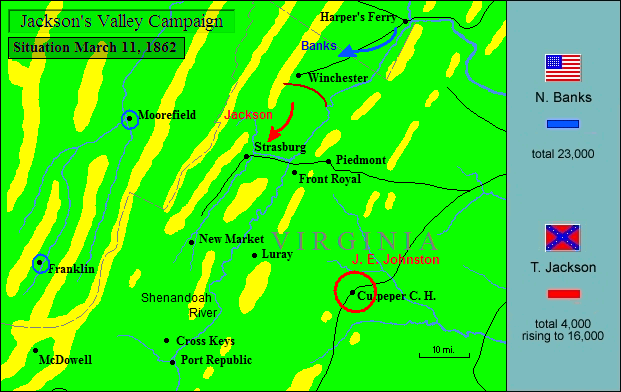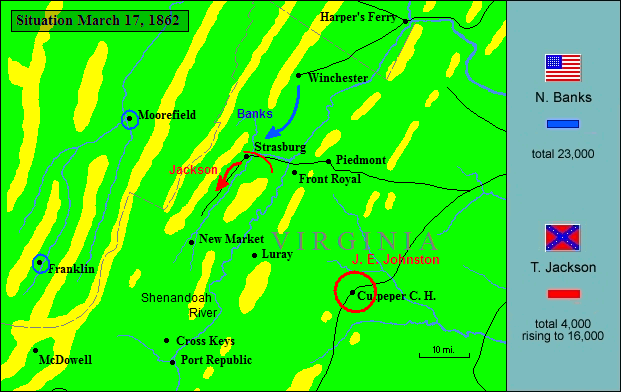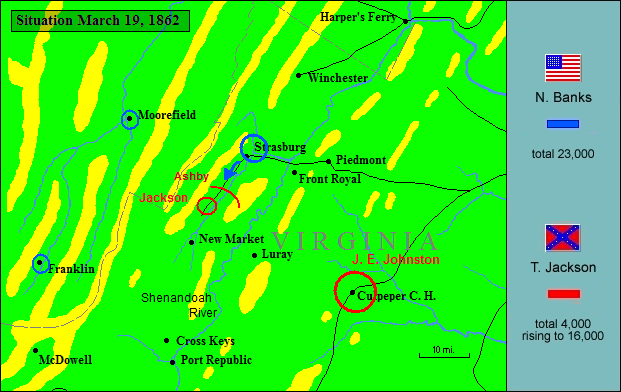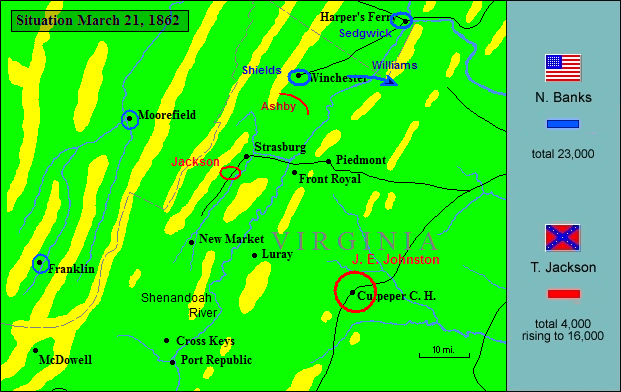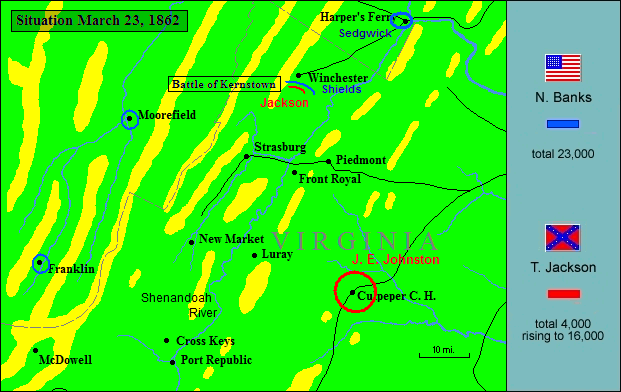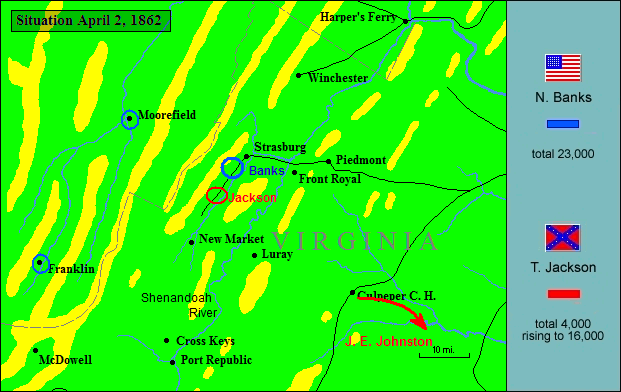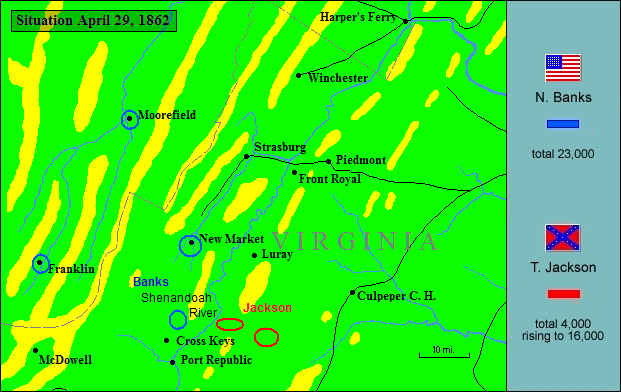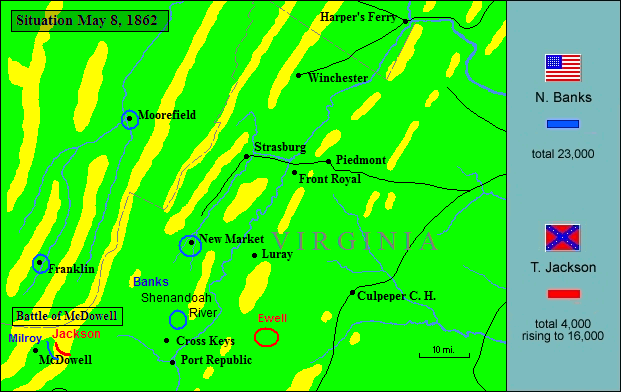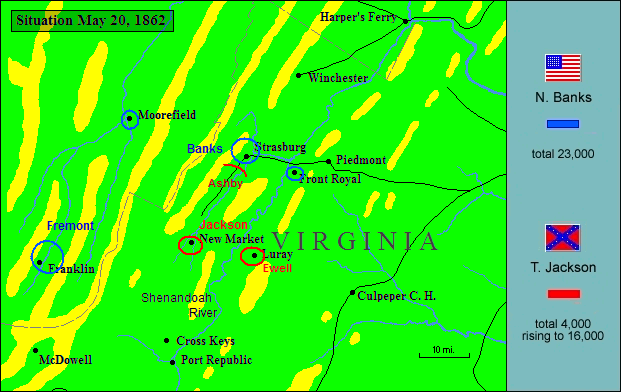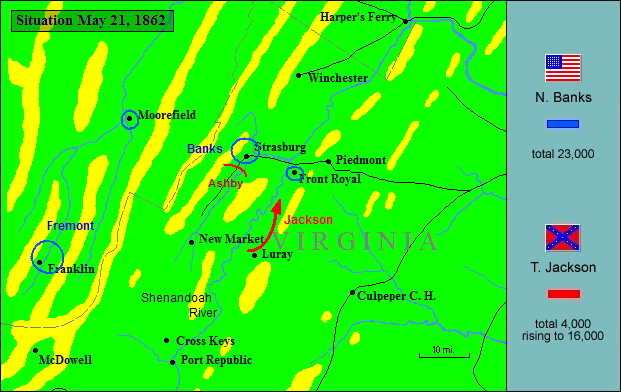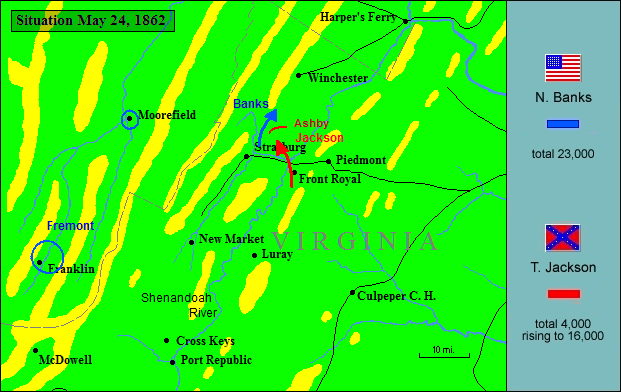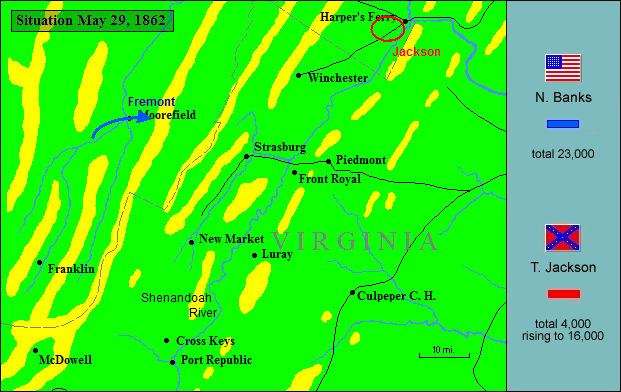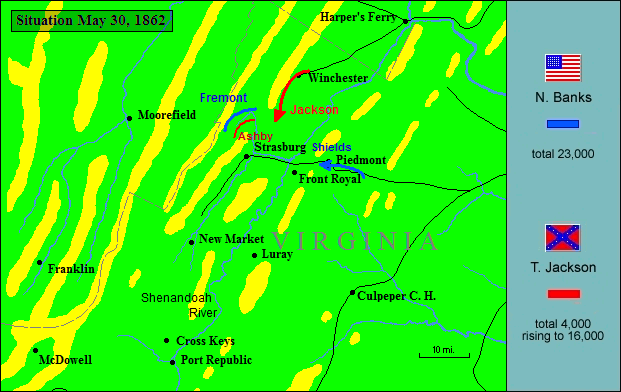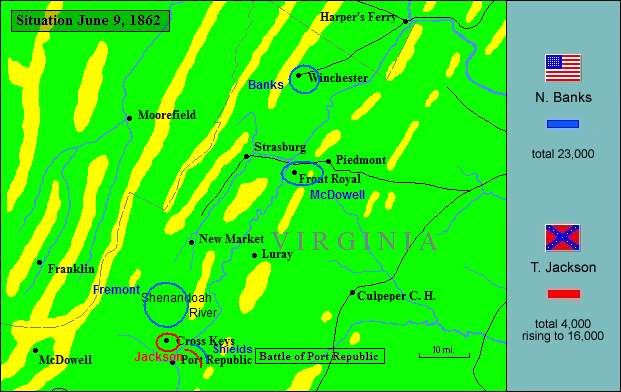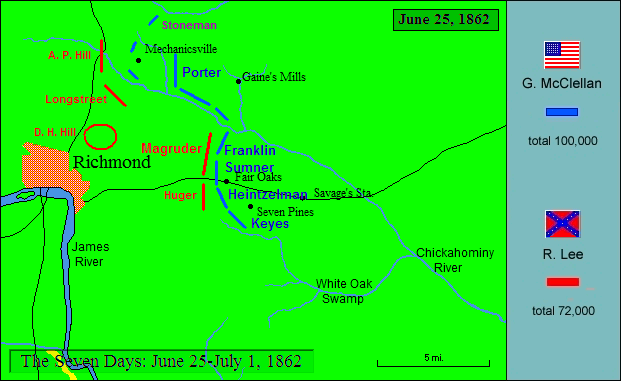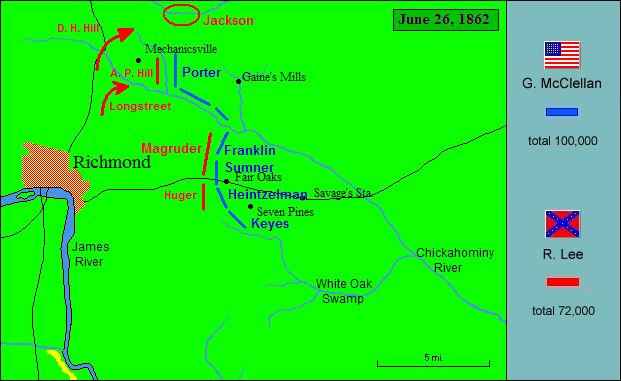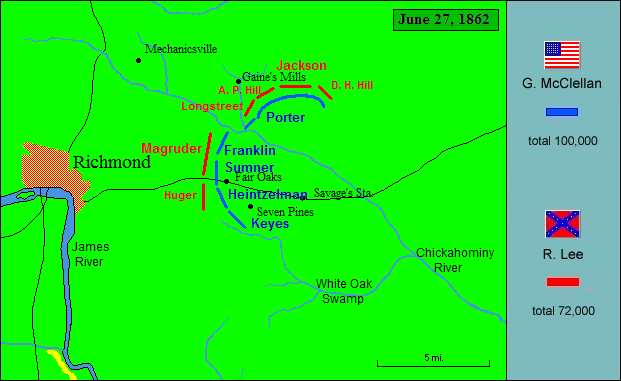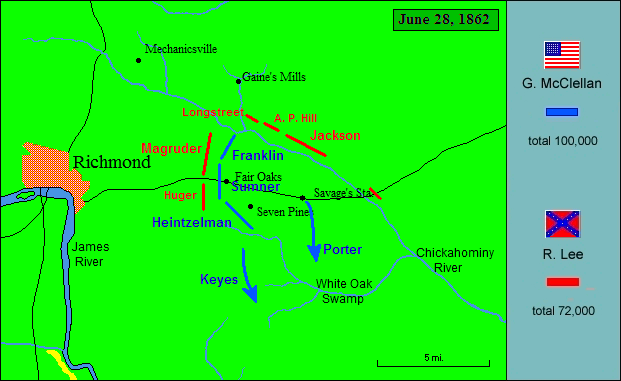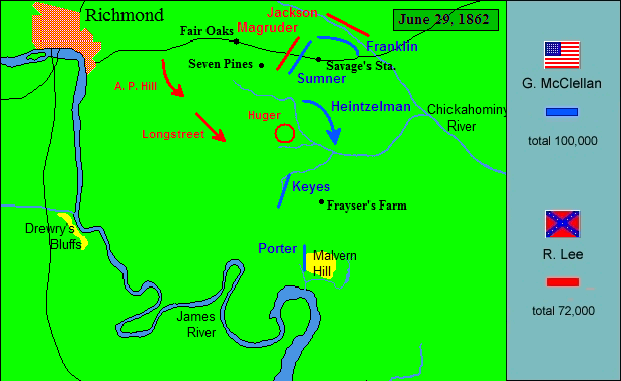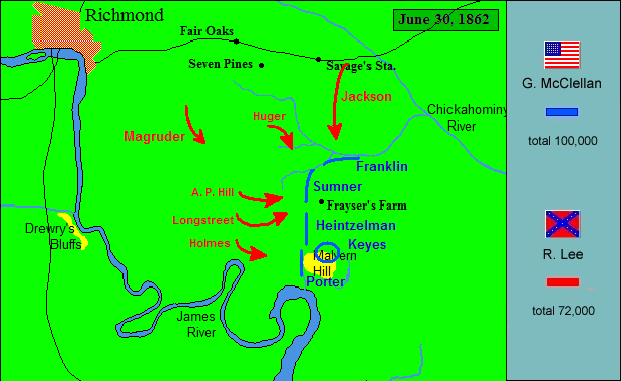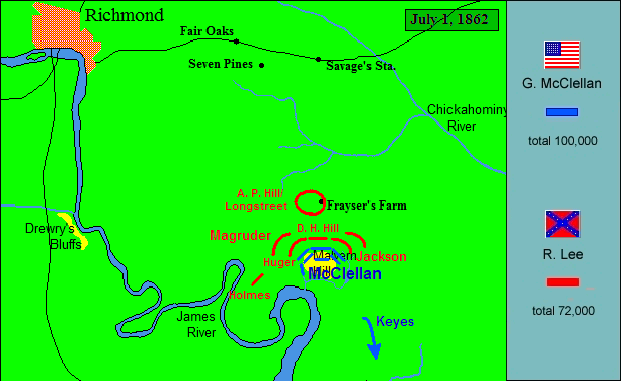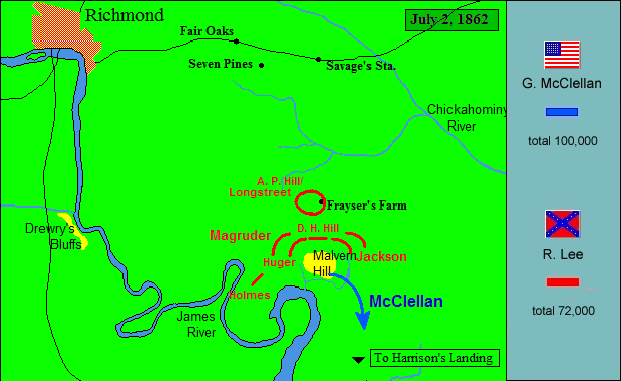Richmond must not be given up, it shall not be given up! –Robert E. Lee
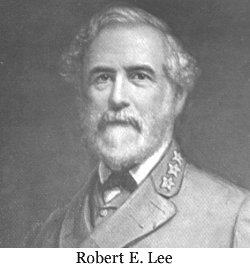
But the blow did not fall. It did not fall because, having made his laborious way up the peninsula, McClellan stalled before Richmond just as he had stalled before Yorktown. Convinced that he now faced 200,000 Confederates, again he thought in terms of siege rather than assault. One of his brigadiers, the combative Phil Kearny, took to calling McClellan “the Virginia creeper.” Back in western Virginia McClellan had once sharply rebuked a subordinate who called for reinforcements and seemed unwilling to take risks and accept responsibility. Now it was McClellan who made the telegraph line to the War Department hum with his urgent calls: he could not possibly take the offensive without McDowell’s corps, he insisted. Lincoln’s secretary of war, relentless and remorseless Edwin Stanton, was beside himself. “If he had a million men,” he exploded, “he would swear the enemy had two millions, and then he would sit down in the mud and yell for three.”
McClellan, however, would neither be reinforced nor take the offensive, for the initiative was about to be seized from him by Robert Edward Lee, the courtly 55-year-old Virginian now serving as Davis’ chief military advisor. Lee’s most immediate anxiety was not McClellan, exactly; Joe Johnston, though outnumbered roughly three to two, stood squarely in his path. It was McDowell and his forty thousand that preoccupied Lee. To keep McDowell away from Richmond, he proposed to go on the offensive west of the Blue Ridge. He would reinforce Stonewall Jackson in the Shenandoah Valley and turn him loose. In the month ahead Jackson would tear up and down the Valley as if he held title to it, and in the end he would keep as many as 60,000 Federals from cooperating with McClellan against the capital.
By any measure, Thomas J. Jackson was an enigma. Described as “a particularly seedy, sleepy-looking old fellow whose uniform and cap were very dirty,” Jackson was a relentless driver who seems genuinely to have loved the shock of combat. His men called him Old Blue Light for the way his piercing blue eyes lit up in battle. They also called him Tom Fool for his bundle of eccentricities: he rode with one arm in the air to keep from going “out of balance”; he sucked lemons constantly; he liked to eat standing up to keep his organs properly aligned, he said. Jackson espoused two things chiefly: a stern Calvinist Christianity and the Confederacy. His army was “an army of the living God, as well as of its country.” There was a great deal of Old Testament holy warrior in the man. As a commander in the Valley, he was nothing less than brilliant. “Always mystify, mislead, and surprise the enemy” was his first principle, and “when you strike and overcome him, keep up the pursuit… Never fight against heavy odds… hurl your own force on only a part… of your enemy and crush it. A small army may thus destroy a large one… and repeated victory may make it invincible.” Jackson’s small army–just 17,000 troops–was in truth invincible the whole length and breadth of the Valley. In one month it marched 400 miles, fought five battles against three different Federal commands, inflicted 7,000 casualties, and seized crucially needed arms, equipment, supplies, plus horses and wagons with which to haul away the spoils. Most important, however, Jackson’s campaign sowed panic in the White House. So it was that McDowell was ordered to cover Washington, not to attack Richmond. In this end, Jackson was sure he saw the workings of divine providence.
In Richmond at the end of May, another act of God–torrential rain–was going to provide the Confederates a rich opportunity to drive McClellan from their beleaguered capital. The Chickahominy River, flowing southwest to join the James east of the city was just then up on its banks and threatening to tear away the bridges over it. McClellan was somewhat awkwardly straddling the river, three corps north of the swollen watercourse and two south of it. If Joe Johnston could with the better part of his force fall on the two isolated corps south of the river, he could pry the Union left wing free from the city. On May 30, the skies opened again, and the next afternoon, after much delay, the attack went forward through the slop. It was, as one of Johnston’s staff officers later admitted, a “phenomenally mismanaged” assault, largely as a result of confused staff work and wrangling over rank and responsibility in the Confederate command. Still, clumsy as it was, it pushed the Federal left a mile or more to the village of Seven Pines; on their right, the Federals were driven back on Fair Oaks on the York River railroad, but the arrival of Edwin “Bull” Sumner’s corps from north of the river stalemated the Rebel attack there, and at dusk the fighting died out. The next day the Yankees, reinforced from their right, took up the fight again, and when it was over, they had regained the lost ground. Two days’ fighting left both sides bloodied but very nearly where they had begun.
Union losses at the Battle of Fair Oaks, as Yankees preferred to remember it, were about six thousand; Confederate losses at Seven Pines, the Rebel designation, were seven thousand. The battle was a stalemate, but it had two profoundly important consequences. The first was in the heart and mind of George B. McClellan. Although he had apparently never been closer to the fighting than two miles, he confessed that he “was tired of the sickening sight of the battlefield, with its mangled corpses and poor suffering wounded. Victory has no charms for me when purchased at such cost.” Historian John Keegan has written of “the will to combat,” which signifies, among other things, a willingness to bear the bloody cost of victory. McClellan, who thought of himself as the protective and loving father of his army, lacked that capacity. A second consequence of Fair Oaks was a single casualty: of the many thousands of fateful missiles fired that day, two were especially so, for they struck and severely wounded Joe Johnston. The next day Jefferson Davis appointed a new commander: Robert E. Lee.
McClellan professed to prefer this change of command. Lee, he thought, was “too cautious and weak under grave responsibility–personally brave and energetic to a fault, he yet is wanting in moral firmness when pressed by heavy responsibility and is likely to be timid and irresolute in action.” It was a remarkably wrong-headed judgment, and perhaps the only way to understand it is to read it as a projection of McClellan’s own anxieties about himself as a commander. For, as one of Lee’s subordinates sharply observed, Lee’s “name might be ‘Audacity.’ He will take more chances and take them quicker, than any other General in this country, North or South.” On June 1, Lee had already begun to formulate a plan to defend Richmond by taking the offensive.
In the generation after the war, the stature of Lee would take on mythic dimensions, making him a “marble man” venerated North and South. But in June of ’62, all people really knew was that he was a career soldier, the son of Light Horse Harry Lee, hero of the Revolution. He had served with distinction in Mexico and was widely regarded in the old army as one of its most outstanding officers. In fact, when war came, Winfield Scott offered command in the East to Lee, an offer Lee declined when Virginia–”my country” to Lee–left the Union. His record thus far in the war, however, was not highly regarded–at least not in the Southern press. When Lee withdrew his command from an indefensible position in western Virginia in the opening months of the war, newspapers dubbed him “Evacuating Lee” and “Granny Lee.” When he strengthened the trenches and redoubts protecting Richmond, the papers crowned him “king of spades.” What the papers did not know, however, was that Lee was preparing a line that could be held by a fraction of his army while the bulk of it pitched into McClellan’s right flank north of the Chickahominy.
The reconnaissance for this attack was to be one of the remarkable feats of the war. Lee sent his cavalry chief, J. E. B. Stuart, to explore the Union right. Stuart relished the role of beaux chevalier, dressing the part from his knee-high boots to the ostrich plume in his hat, and he was all cavalryman. On June 12, with 1,200 troopers he crossed the Chickahominy north of Richmond and turned southeast. Four days and a hundred miles of hard galloping later he again crossed the Chickahominy, this time over an improvised bridge south of Richmond. He had ridden an entire circle around McClellan’s army, gathering information, skirmishing, making slashing raids, taking prisoners, capturing stores, destroying telegraph lines–and occasionally playing the gallant for admiring belles. It was a brilliant raid and reconnaissance. Among the Yankee horsemen in futile pursuit of Stuart happened to be Philip St. George Cooke, a Virginia Unionist and Stuart’s father-in-law. Cooke would regret his loyalty to the Union but once, said Stuart acidly, “and that will be continuously.”
Stuart’s splendid ride gave him what he cherished–glory; it gave Lee what he needed–sound intelligence. In the fighting at Fair Oaks and Seven Pines McClellan had shifted most of his army south of the river. Now only Fitz-John Porter’s V Corps remained north of it with its right in the air. Lee would hold the Richmond lines with 27,000 while marching north of the river with three divisions. The linchpin of the plan was Stonewall Jackson, secretly arrived from the Valley and now north of Richmond. While Jackson fell on Porter’s exposed flank, A. P. Hill, one of Lee’s most capable lieutenants, would strike his front. North of the river they would outnumber the Yankees two to one. Of course, that meant that south of the river there would still be 75,000 Yankees opposite a line held by 27,000 under John B. Magruder. Magruder was no doubt a wise choice: he had after all held a thirteen-mile front at Yorktown with a handful of men and playacting. Lee also felt he understood his antagonist, an uncanny perceptive power he showed throughout the conflict. Magruder would keep busy on his front, and McClellan, he was sure, would not strike for Richmond.
The attack was scheduled for June 26. A. P. Hill was in line and ready, impatiently waiting for Jackson to come up on his left. Jackson’s army had recently established its reputation as “foot cavalry” in the Shenandoah Valley, but by mid-afternoon it had still not arrived. Jackson’s performance throughout the coming fighting would in fact be sluggish. It may be that, after the pounding campaign in the Valley, Jackson was simply exhausted in mind and body. One Rebel said he “appeared worn down to the lowest point of flesh consistent with active service.” In any case, Hill, an aggressive fighter who liked to ride into a fight in his red battle shirt, decided not to wait. On his own initiative, he sent his attack forward against Porter’s corps entrenched along Beaver Dam Creek near Mechanicsville. Unsupported by Jackson who was even then just a few miles to the north, Hill’s division ran into heavy and determined rifle fire and was repulsed. It suffered 1,500 casualties and accomplished nothing. To Washington that night, a jubilant McClellan wired: “Victory of today complete and against great odds. I almost begin to think we are invincible.”
McClellan’s mood, however, quickly shifted to anxiety when he learned that Jackson was now on hand–his reputation preceding him. If the Army of the Potomac had fought against “great odds” that afternoon, he reasoned, the odds the next day must be overwhelming. Then, too, he began to worry about the security of his supply line north of the Chickahominy, now threatened by Jackson on his right. Magruder had been active on his left all day also, making noisy demonstrations with both infantry and artillery, so that it seemed to McClellan that he was being assailed everywhere. Despite his complete victory at Mechanicsville and his invincible army, McClellan that night ordered Porter to withdraw. The latter fell back four miles, taking up a strong position above Boatswain’s Swamp near Gaine’s Mill. At the same time, McClellan made preparations to shift his base to the James River. He was about to be pushed off the Peninsula.
The next morning, June 27, Lee was ready to give him another hard shove, again aimed at Porter north of the river. Powell Hill was to strike Porter in the center, James Longstreet demonstrate on his left, and Jackson come down sharply on his right. Porter would have to respond to the pressure somewhere. If he moved to meet Jackson, Longstreet would make a full-scale attack. Although the ensuing attack was not as mismanaged as the fight at Fair Oaks, it was not managed well either. Again Jackson was late getting off, and in consequence Hill’s division, fighting pretty much on its own, took a fierce mauling in the marshes and brushy hills. Although outnumbered, Porter’s line was strong and effectively supported by artillery. Throughout the afternoon the Yankees kept up a punishing fire. Near dusk, though, Lee succeeded in getting all his divisions in line and off together. Porter’s corps buckled in the center–pierced by a Texas brigade led by fierce, great-bearded John Bell Hood; then it broke. The Yankees ran in full retreat toward the bridges that would take them south of the river, leaving behind 22 guns and 2,800 prisoners. Realizing at last the seriousness of the threat on his right, McClellan sent help–about 6,000 men in all–but they were too late to do anything but form a rearguard to cover the retreat.
The Battle of Gaine’s Mill had been a long violent day to be sure. In addition to their nearly three thousand captured, the Federals lost four thousand killed and wounded. Lee held the field and the initiative at a cost of nine thousand casualties. One Rebel artilleryman described the bloody business in the vivid language of the old-time religion that both armies shared: “Satan was holding his orgies on earth & death supped fat on the feast.” McClellan, who had yesterday wired Washington of his complete victory, now sent this almost hysterical report to Secretary of War Stanton: “I have lost this battle because my force was too small. I again repeat that I am not responsible for this… The Government has not sustained this army. If you do not do so now the game is lost. If I save this army now, I tell you plainly I owe no thanks to you or to any other persons in Washington. You have done your best to sacrifice this army.” It was an extraordinary message for a commander in the field to send the secretary of war, and a judicious colonel in the telegraph office deleted the last two sentences before giving it to Stanton. Actually, McClellan’s report had one grain of truth: he had lost the battle because his force was too small–north of the Chickahominy. South of it he had nearly 70,000 armed men who did nothing much that day but watch Magruder’s shams and listen to the distant thunder. But for the Army of the Potomac that was a moot point now, for Little Mac had made up his mind to withdraw to Harrison’s Landing on the James River.
Robert E. Lee, however, was very much disinclined to let him go unmolested. ln fact, Lee believed that an opportunity to destroy the Army of the Potomac was at hand. To reach Harrison’s Landing to the south, McClellan’s columns would have to tramp the narrow roads that ran through White Oak Swamp. If Lee could strike them on the flank hard enough, he might break McClellan’s army into pieces. At Savage’s Station on June 29, three miles below the Chickahominy, Lee ordered an attack on a Yankee rear guard of three divisions. Magruder would fall on them from the west and Jackson from the north. But Magruder went forward slowly and inexpertly with only half his division, and his attack was easily blunted. Jackson spent the day building a bridge over a creek he might simply have forded, and never got in the fight at all. McClellan’s long wagon trains were still rolling south. A frustrated Lee tried again the next day to bring the Yankees to bay. At Glendale on the fields of Frayser’s Farm, Lee hoped again to strike McClellan’s flank from the west with the bulk of his army while Jackson pitched in on his rear. Longstreet and Hill got most of their commands into the fight, and a bitter fight it was, at times hand-to-hand. Incredibly, however, Jackson, with 25,000 men north of White Oak Swamp, was just then taking a nap! At Frayser’s Farm, Confederates took a thousand prisoners and inflicted nearly two thousand casualties but paid for them with 3,500 of their own–and still, McClellan marched south toward safety.
By July 1, Lee was furious. (Beneath the courtly dignity was a volatile temper.) McClellan was escaping, he exploded, “because I cannot have my orders carried out!” Now the Yankees were at Malvern Hill, three miles south of Glendale, and on good ground: the slope was long and steep and on the flanks were deep ravines. At the top were four Federal divisions supported by 100 guns. Malvern Hill did not present good odds for a Confederate attack, but Lee, believing the Yankees beaten and demoralized, sent Magruder and D. H. Hill forward. McClellan may have been demoralized, but the Yankee riflemen and gunners were not. The Rebel brigades struggled up the slope and into a slaughter. Artillery fire that day was especially punishing, and Malvern Hill was one of the very few engagements of the war in which artillery fire inflicted more casualties than rifle fire. D. H. Hill later thought the battle “was not war–it was murder.” The next morning many of the 5,500 Rebel casualties were still on the field. A Yankee colonel remembered that morning: “Our ears had been filled with agonizing cries from thousands before the fog was lifted, but now our eyes saw five thousand dead or wounded men on the ground. A third of them were dead or dying, but enough of them were alive and moving to give the field a singularly crawling effect.” No one could doubt the private soldier’s will to combat.
To some in the Federal high command, the bloody repulse of Lee at Malvern Hill meant an opportunity to go back on the offensive. The Army of Northern Virginia had after all suffered 20,000 casualties in the nearly continuous fighting of the Seven Days; the Army of the Potomac half that figure. The Federals’ numerical superiority, despite their losses, had actually increased. Instead of retreating, Phil Kearney argued, “We ought… to follow up the enemy and take Richmond.” An order to retreat “can only be prompted by cowardice or treason.” But, whatever the motive, McClellan gave the order to fall back on the James (not a retreat, he insisted, but a change of base). By his lights, he had saved his army from destruction at the hands of overwhelming numbers. The Seven Days Battle had been a strange campaign. In five fierce collisions–Mechanicsville, Gaines’ Mill, Savage’s Station, Frayser’s Farm, and Malvern Hill–Lee had suffered four tactical defeats and gained but one tactical victory (Gaines’ Mill). But it was McClellan who retreated, and it was Lee who continued to drive on with a hard resolve. McClellan hoped to save his army; Lee strove to destroy it. Lee may well have done so had he been better served by many of his lieutenants–Jackson being the signal example. “Under ordinary circumstances,” he wrote, “the Federal Army should have been destroyed.” In any case, for the moment both sides would catch their breath. On July 4, the second Independence Day of a house divided, the opposing picket lines were still close. One Rebel remembered the Fourth this way:
There are blackberries in the fields so our boys and the Yanks made a bargain not to fire at each other, and went out in the field… and gathered berries together and talked over the fight, and traded tobacco and coffee and newspapers as peacefully and kindly as if they had not been engaged for… seven days in butchering one another.
A few days later the soldiers of the Army of the Potomac were camped at Harrison’s Landing. They had gotten close enough to Richmond to hear the striking of the public clocks. There was going to be a great deal more butchering before they got that close again.

